
(UPDATE: Having spoken to a Costume Historian - he doesn't think this dress is genuine. It comes in connection with a film and whereas we thought it was the basis of the film's dress, it now seems as if this is the replica! Which makes our using this dress as an example of what we are talking about here rather redundant - but the problem remains the same so please read on!!!!)
We are a bit bemused!
Today, we sat down with the sole purpose to start the research and sampling process for the Robe a l'Anglais that will match the Philadelphia Stays and we have suddenly hit a rather surprising wall.
Our general understanding was that Stays kind of fell into 3 categories:
- Fully Functional Stays - that were worn above the shift and under all other garments and designed to create the shape ONLY and not be seen.
- Stomacher Styled Stays - that had decorative fronts and were worn above the shift and jutted out over the petticoat with the CF point. That were also functioning stays and fully boned. Could be covered, decorated with ribbons, fabric or furbellows.
- Training Stays and Jumps.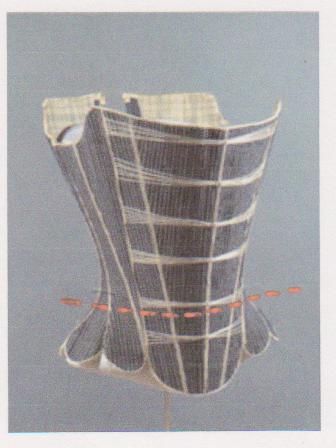
- Fully Functional Stays - that were worn above the shift and under all other garments and designed to create the shape ONLY and not be seen.
- Stomacher Styled Stays - that had decorative fronts and were worn above the shift and jutted out over the petticoat with the CF point. That were also functioning stays and fully boned. Could be covered, decorated with ribbons, fabric or furbellows.
- Training Stays and Jumps.

This is the problem that we are facing. As you can see from the above image the waist line is a good 3 1/2" to 4" above the 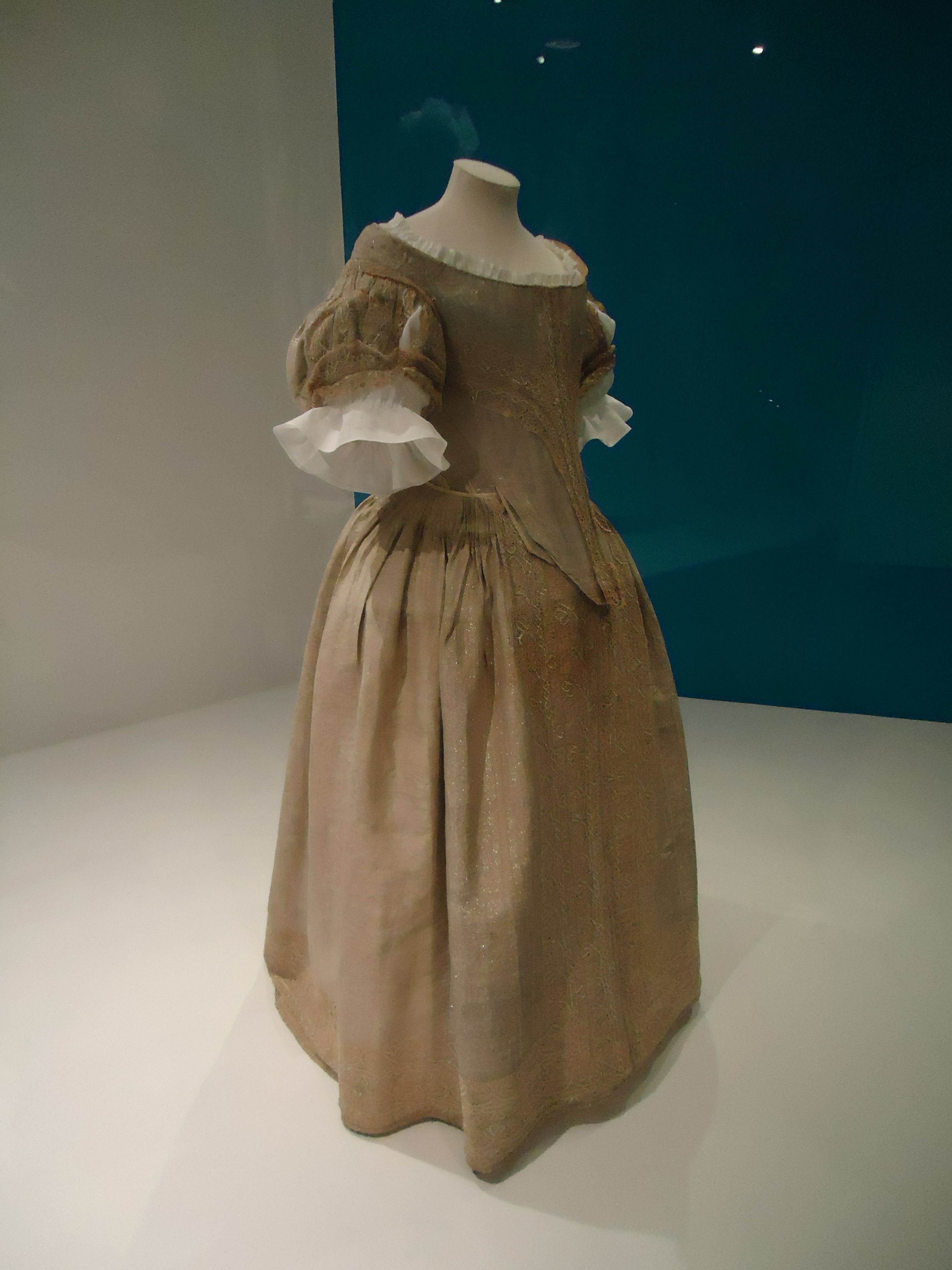 first tab indent. Now, we know that we have cut out our version of these stays a little low compared to this pair - on our next sample the whole bottom hem will be brought up by about 1 1/2", but even with this alteration we would still be facing the same problem. The hip-pads and petticoat would have to be tied on way beneath the line of the first white thread decoration bit and would struggle (surely!) with falling off. Plus, the neat high-waisted line so famous in the Robe a l'Anglais and Robe a la Francais dresses would be lowered dramatically if this happened.
first tab indent. Now, we know that we have cut out our version of these stays a little low compared to this pair - on our next sample the whole bottom hem will be brought up by about 1 1/2", but even with this alteration we would still be facing the same problem. The hip-pads and petticoat would have to be tied on way beneath the line of the first white thread decoration bit and would struggle (surely!) with falling off. Plus, the neat high-waisted line so famous in the Robe a l'Anglais and Robe a la Francais dresses would be lowered dramatically if this happened.
 first tab indent. Now, we know that we have cut out our version of these stays a little low compared to this pair - on our next sample the whole bottom hem will be brought up by about 1 1/2", but even with this alteration we would still be facing the same problem. The hip-pads and petticoat would have to be tied on way beneath the line of the first white thread decoration bit and would struggle (surely!) with falling off. Plus, the neat high-waisted line so famous in the Robe a l'Anglais and Robe a la Francais dresses would be lowered dramatically if this happened.
first tab indent. Now, we know that we have cut out our version of these stays a little low compared to this pair - on our next sample the whole bottom hem will be brought up by about 1 1/2", but even with this alteration we would still be facing the same problem. The hip-pads and petticoat would have to be tied on way beneath the line of the first white thread decoration bit and would struggle (surely!) with falling off. Plus, the neat high-waisted line so famous in the Robe a l'Anglais and Robe a la Francais dresses would be lowered dramatically if this happened.
On the right here is am image of a dress exhibiting the way that we thought these Stays would work. This is a dress from the previous century entitled 'The Silver Tissue Dress' and can be found in the Bath Fashion Museum.
As you can see from the image that the Centre Front (CF) point sits out over the petticoat while the rest gets tucked in inside the waistband. There are Stays out there that do work like this - the evidence of it being the height of the first tab and how it almost sits at the waistline, but there are also some Stays out there that just clearly don't.
Here is an image of the order of dressing as given by Linda Baumgarten and John Watson.
Order Featured in Image Above:
- Shift on first.
- Then the stays.
- Next the pockets are tied on.
- Then the Hooped Petticoat is tied on over the top of the Stays
- Then the Dresses Petticoat is tied on
- And then finally the dress is placed on.
- Then the stays.
- Next the pockets are tied on.
- Then the Hooped Petticoat is tied on over the top of the Stays
- Then the Dresses Petticoat is tied on
- And then finally the dress is placed on.
IF we used this above dressing order for dressing our Philadephia Stays then there would be no visible point seen of the Stays as it would be hidden under the Petticoat and the Hooped Petticoat and there wouldn't be a flat and reliable surface either as each of the afore-mentioned petticoats have gathers and fullness that would bulk out the waistline.
Lets see if we can explain what we mean...
Lets see if we can explain what we mean...
Here's a close-up of the detail of the Silver Tissue Dress:
As you can see the Centre Front (CF) point clearly juts out over the petticoat whereas the rest of the tabs all sit under the petticoat at the sides and back. This is how we envisioned ours working but if you look at the image of the Philadelphia Stays at the start of this Post, for the petticoat to act like this image here, it would have to sit well below the waist line.
Each tie-on item would create the same problem: either interrupt the decorated front or get lowered to well below the waistline.
- We've done a quick sketch to try and show the other variations of problems. (super-quick sketches!)
- First is the a drawing of what the Hip pads would look like tied on.
- We've done a quick sketch to try and show the other variations of problems. (super-quick sketches!)
- First is the a drawing of what the Hip pads would look like tied on.
- There are about 4 things that we can think of that get tied on in the dressing process. These are as follows:
- The Hip Pads or Hoops
- The Pockets
- The Petticoat
- The dress.
Even the dresses had a tie that was sewn at the CB of the lining and tied round over the stays and under the stomacher. This 'tying' it on helped hold the back of the dress tight against the corset and played a part in creating that beautifully flat and neat back that the Robe a l'Anglais present so perfectly.
- The Hip Pads or Hoops
- The Pockets
- The Petticoat
- The dress.
Even the dresses had a tie that was sewn at the CB of the lining and tied round over the stays and under the stomacher. This 'tying' it on helped hold the back of the dress tight against the corset and played a part in creating that beautifully flat and neat back that the Robe a l'Anglais present so perfectly.
Next, having thought about this issue we used a skirt from the Bath Fashion Musuem to open our minds to the idea of having the petticoat have a CF opening to sit under our lowered CF point but then stretch the rest up to the waistline and sit where it should be. We thought we'd got it but again the same problem...there is another set of ties still in the way.
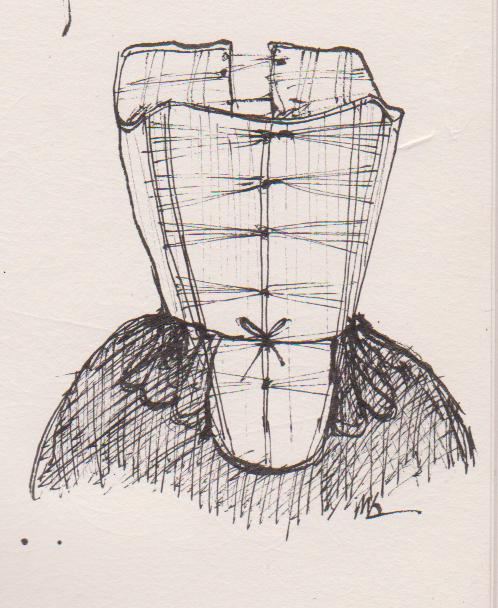 - As you can see from both these images that this way of cutting the petticoat would work and does seem to have been done before.
- As you can see from both these images that this way of cutting the petticoat would work and does seem to have been done before.
- We emailed a couple of museums about this problem in our search and the Manchester Art Galleries got back to us saying they had found the same problem with their Red Stays from the previous century. We found this mightily encouraging.
- It also raises another interesting problem we've not really seen before. Most of the Stomachers in the museums tend to be fairly flimsy, a few have bones in but certainly not enough bones to create a centre flat front. So then, how did they not buckle and bump over the ties and the bulk of the petticoats being tied on? Just another interesting ponder. If you look at the very first image of this Post it makes you wonder that if that centre piece is a Stomacher and not part of a matching pair of Stays then was it a) unlike any other Stomacher we've ever seen and stiffened with paste and boned and curved or b) stretched tort and tight over the Stays beneath it. In which case this Stays would have had to be pretty much the same shape as the Stomacher and again going over the petticoat to create such a uniformed and smooth look. Have a look at it now and just think of the logistics of how it was done. What we need to do is find out which Museum this dress is from and actually ask them how it works. We personally thinks it's a pair of Stays as if you look at the bottom of the centre piece you can see this fine binding and it also curves at that CF point in the exact same way that Stays curved at this time, in the 40's.
- Our main point of interest is, is not so much finding a way round it - rather knowing how they actually did it - how did they actually dress themselves - what examples of this do we have in our museums, what recollections do we have in their letters. We know it's endless to say 'this needs more research' but it simply does. One day we find an excerpt in a letter mentioning this exact thing. But until that day we shall just have to use our brains and find our own solution.
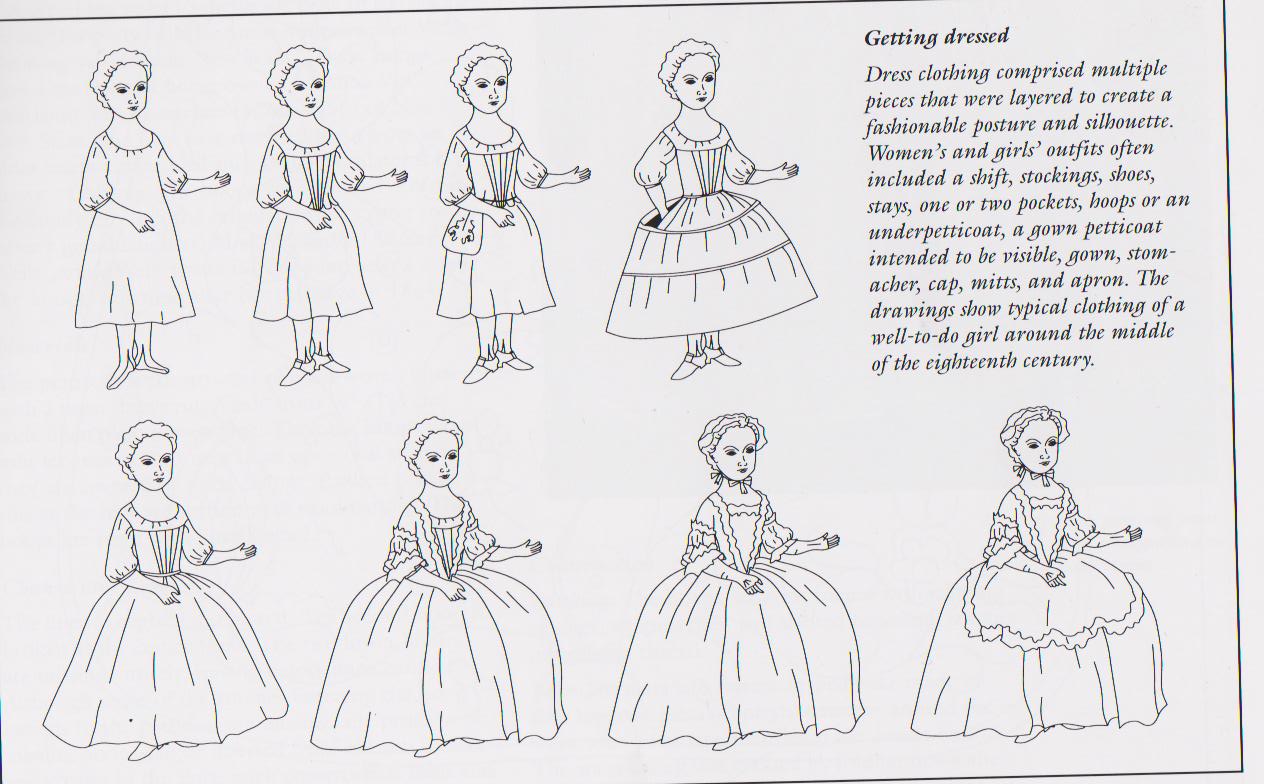
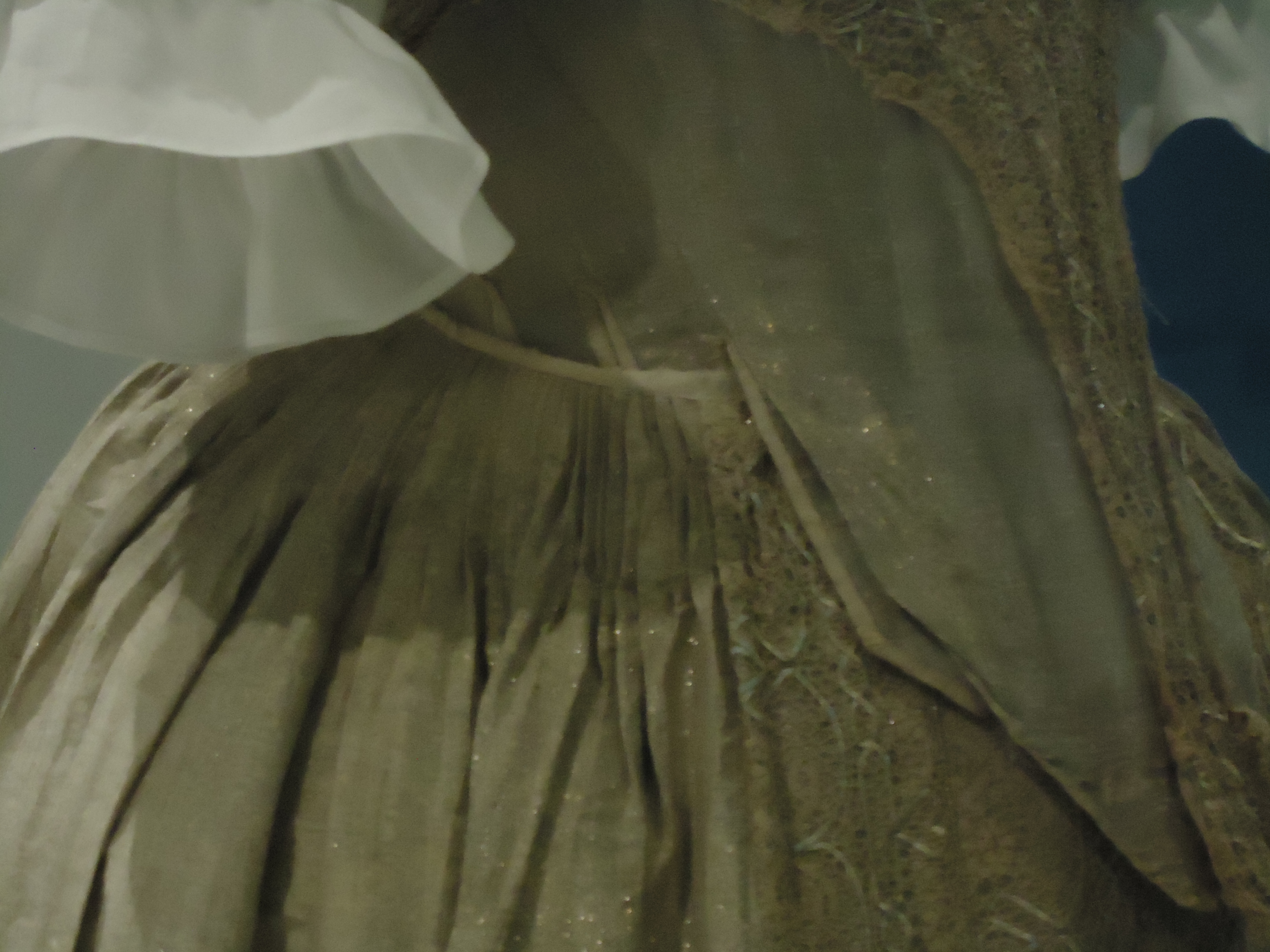


No comments:
Post a Comment